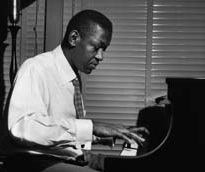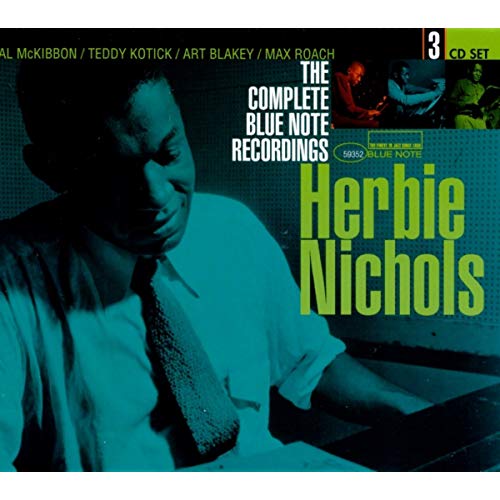Riff Primitif – Herbie Nichols
One of Herbie Nichols' most complex and challenging compositions, especially with its rapid sequence of descending minor/major 7th chords. Piano Melody Transcriptions are available for both the master and alternate takes.
- Recording: Herbie Nichols - Complete Blue Note Recordings of Herbie Nichols
- Recorded on: April 19, 1956
- Label: Mosaic (MR5-118)
- Concert Key: C
- Vocal Range: , to
- Style: Swing (uptempo)
- Piano - Herbie Nichols
- Bass - Teddy Kotick
- Drums - Max Roach
0:00
0:00
Buy MP3
Video
- Description
- Historical Notes
- Solos
- Piano Corner
- Bass Corner
- Drum Corner
- Guitar Corner
- Inside & Beyond
- Minus You
This song is a real challenge, both melodically and harmonically. The melodic lines sneak and wind around in unpredictable intervals, and though the changes are at times straightforward there are some very tricky points in the harmonic structure. Though the key seems at first to be C minor, there are enough harmonic and melodic implications of C major that our lead sheets have no key signature.
Our audio clip starts with the melody. The changes start out relatively straightforwardly in C minor, though with an unexpected Gm(maj7) on the last two beats of the second measure—an omen of trouble down the road! On the first A section, minor/major 7th chords descend stepwise, two per measure, from another Gm(maj7) down to Dm7♭5, but it's on the second A section where things really get tricky with these chords. The sixth and seventh measures of this section have an unexpected second descending sequence of the same chord quality, one per beat for five beats with the last, D♭m(maj7), held for a measure and a half. The melody here—and in many other places in the song—goes slightly outside the changes. The descending m(maj7) chords feature an arpeggiated melodic sequence that actually contains the minor 7ths of the chords—on the recording the major 7ths are in the left hand voicings. The sixth measure of the second A section has another clash, with G♯ (the major 3rd) over Em(maj7).
The bridge continues the melodic convolutions, with slightly more conventional changes—descending II-V7s from F♯m7b5; in the second measure there is an unexpected C9/E chord that is actually just an anticipation of the chord in the next measure, Em7♭5. The melody of the second half of the bridge develops a rising 16th-note figure from the end of the first A section. As with a few other Nichols songs, the C section is extended to ten measures; this extension doubles up on the descending m(maj7) chords so that here there are three back-to-back descending sequences of these chords! An unexpected rest leads to the final C chord, which is written as a major 6th but Herbie often plays a minor chord here.
The intro CLIP is eight measures long and starts with a repeated-note figure accompanied by open fifths, alternated with another winding phrase with a harmonic minor sound, and then the last phrase from the melody, ending on D♭m(maj7) as in the second A section. As an intro it is followed by four measures of drum solo; when it reappears as a coda, the last chord is held into the drum solo which in the master take is six measures, but in the alternate take only four plus a final hit on the downbeat of a fifth measure.
Piano Melody Transcriptions are available for the in and out heads of both the master and alternate takes; click on Piano Corner for more details.
Our audio clip starts with the melody. The changes start out relatively straightforwardly in C minor, though with an unexpected Gm(maj7) on the last two beats of the second measure—an omen of trouble down the road! On the first A section, minor/major 7th chords descend stepwise, two per measure, from another Gm(maj7) down to Dm7♭5, but it's on the second A section where things really get tricky with these chords. The sixth and seventh measures of this section have an unexpected second descending sequence of the same chord quality, one per beat for five beats with the last, D♭m(maj7), held for a measure and a half. The melody here—and in many other places in the song—goes slightly outside the changes. The descending m(maj7) chords feature an arpeggiated melodic sequence that actually contains the minor 7ths of the chords—on the recording the major 7ths are in the left hand voicings. The sixth measure of the second A section has another clash, with G♯ (the major 3rd) over Em(maj7).
The bridge continues the melodic convolutions, with slightly more conventional changes—descending II-V7s from F♯m7b5; in the second measure there is an unexpected C9/E chord that is actually just an anticipation of the chord in the next measure, Em7♭5. The melody of the second half of the bridge develops a rising 16th-note figure from the end of the first A section. As with a few other Nichols songs, the C section is extended to ten measures; this extension doubles up on the descending m(maj7) chords so that here there are three back-to-back descending sequences of these chords! An unexpected rest leads to the final C chord, which is written as a major 6th but Herbie often plays a minor chord here.
The intro CLIP is eight measures long and starts with a repeated-note figure accompanied by open fifths, alternated with another winding phrase with a harmonic minor sound, and then the last phrase from the melody, ending on D♭m(maj7) as in the second A section. As an intro it is followed by four measures of drum solo; when it reappears as a coda, the last chord is held into the drum solo which in the master take is six measures, but in the alternate take only four plus a final hit on the downbeat of a fifth measure.
Piano Melody Transcriptions are available for the in and out heads of both the master and alternate takes; click on Piano Corner for more details.
This session from "The Complete Blue Note Recordings Of Herbie Nichols" was recorded at Rudy Van Gelder's legendary Hackensack Studio.
Riff Primitif has a few qualities in common with another Herbie Nichols song, Cro-Magnon Nights, which he recorded on his first Blue Note session on May 6th, 1955. Both songs have an arpeggiated sequence in the melody on the fifth and sixth measures, as well as a repeated-note intro. Evidently Herbie had a few specific melodic structures he associated with early humans.
Riff Primitif is the only song from Herbie's Blue Note session that he also recorded on his Bethlehem session of November 10th, 1957 (the album "Love, Gloom, Cash, Love"), but this version, and five other songs from that session, appear to be lost. The Herbie Nichols Project, led by pianist Frank Kimbrough, a participant in jazzleadsheets.com's Herbie Nichols Piano Summit and Herbie Nichols Centennial Project, recorded a version on their second album, "Dr. Cyclops' Dream," in 1999.
Check out other titles from Mosaic Records' "Complete Blue Note Recordings Of Herbie Nichols" release.
Riff Primitif has a few qualities in common with another Herbie Nichols song, Cro-Magnon Nights, which he recorded on his first Blue Note session on May 6th, 1955. Both songs have an arpeggiated sequence in the melody on the fifth and sixth measures, as well as a repeated-note intro. Evidently Herbie had a few specific melodic structures he associated with early humans.
Riff Primitif is the only song from Herbie's Blue Note session that he also recorded on his Bethlehem session of November 10th, 1957 (the album "Love, Gloom, Cash, Love"), but this version, and five other songs from that session, appear to be lost. The Herbie Nichols Project, led by pianist Frank Kimbrough, a participant in jazzleadsheets.com's Herbie Nichols Piano Summit and Herbie Nichols Centennial Project, recorded a version on their second album, "Dr. Cyclops' Dream," in 1999.
Check out other titles from Mosaic Records' "Complete Blue Note Recordings Of Herbie Nichols" release.
Piano Melody Transcriptions are available for both the master and alternate takes. The master take has a notable mistake: Herbie comes in with the C section melody two beats early. In the transcription, the last measure of the B section is in 2/4. Herbie plays dark, low-register left hand voicings throughout the in head and most of the out head. He never plays every one of the descending minor/major seventh chords in sequence, instead usually playing the chords on beats 1 and 3. Sometimes he plays different chords here (usually a step away), whose chord symbols are shown below the staff; the bass continues the original chords' roots.
Herbie harmonizes the melody note on the fourth measure of the bridge (C♯) with G♯ above; the underlying chord is A7, not Amaj7, though that latter chord is written below the staff in places where he doesn't play a chord in the left hand. He only plays A7 here on the in head of the alternate take.
In the out head of the master take, he plays the first half of the first A section and the second half of the second A section an octave higher CLIP. The alternate take's out head has different octave displacement: both A sections start an octave higher, but the first then moves to two octaves higher while the second goes back to the original octave CLIP. The alternate take also has a rhythmic blooper in the in head: he delays the final chord on the last two measures and extends it by two beats. The transcription adds a 2/4 measure before the last two measures for the time to work out. The two A sections of the alternate take's in head have the same left hand voicings; we have a repeat on this A section as in the lead sheet.
Herbie harmonizes the melody note on the fourth measure of the bridge (C♯) with G♯ above; the underlying chord is A7, not Amaj7, though that latter chord is written below the staff in places where he doesn't play a chord in the left hand. He only plays A7 here on the in head of the alternate take.
In the out head of the master take, he plays the first half of the first A section and the second half of the second A section an octave higher CLIP. The alternate take's out head has different octave displacement: both A sections start an octave higher, but the first then moves to two octaves higher while the second goes back to the original octave CLIP. The alternate take also has a rhythmic blooper in the in head: he delays the final chord on the last two measures and extends it by two beats. The transcription adds a 2/4 measure before the last two measures for the time to work out. The two A sections of the alternate take's in head have the same left hand voicings; we have a repeat on this A section as in the lead sheet.
Related Songs
Email Send Riff Primitif to a friend
Send this page to a friend via email. Add your name or email in the first field. In the second, add one or more email addresses, separated by a comma.

Herbie Nichols
January 3, 1919 – April 12, 1963
Don Sickler "On January 3, 2019, we were at the Van Gelder Recording Studio celebrating Herbie's 100th birthday with his family and pianists Frank Kimbrough and Glenn Zaleski. Both Frank and Glenn each recorded a previously unrecorded Herbie Nichols composition, on the same piano Herbie played for his Blue Note sessions. These were the initial recordings that started my new project, the Herbie Nichols Centennial Project, which debuts January 3, 2024. Read more...
There was a problem.
...

